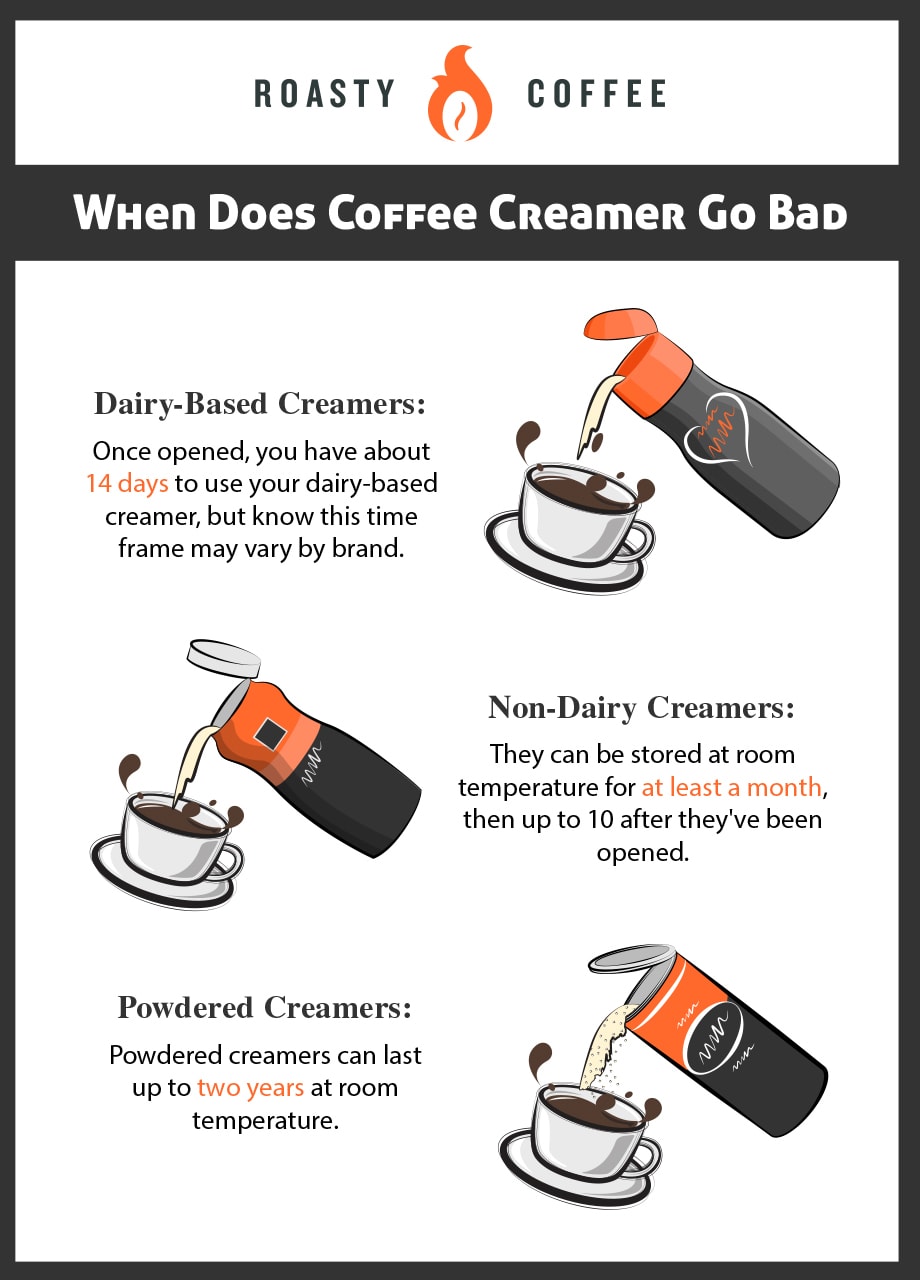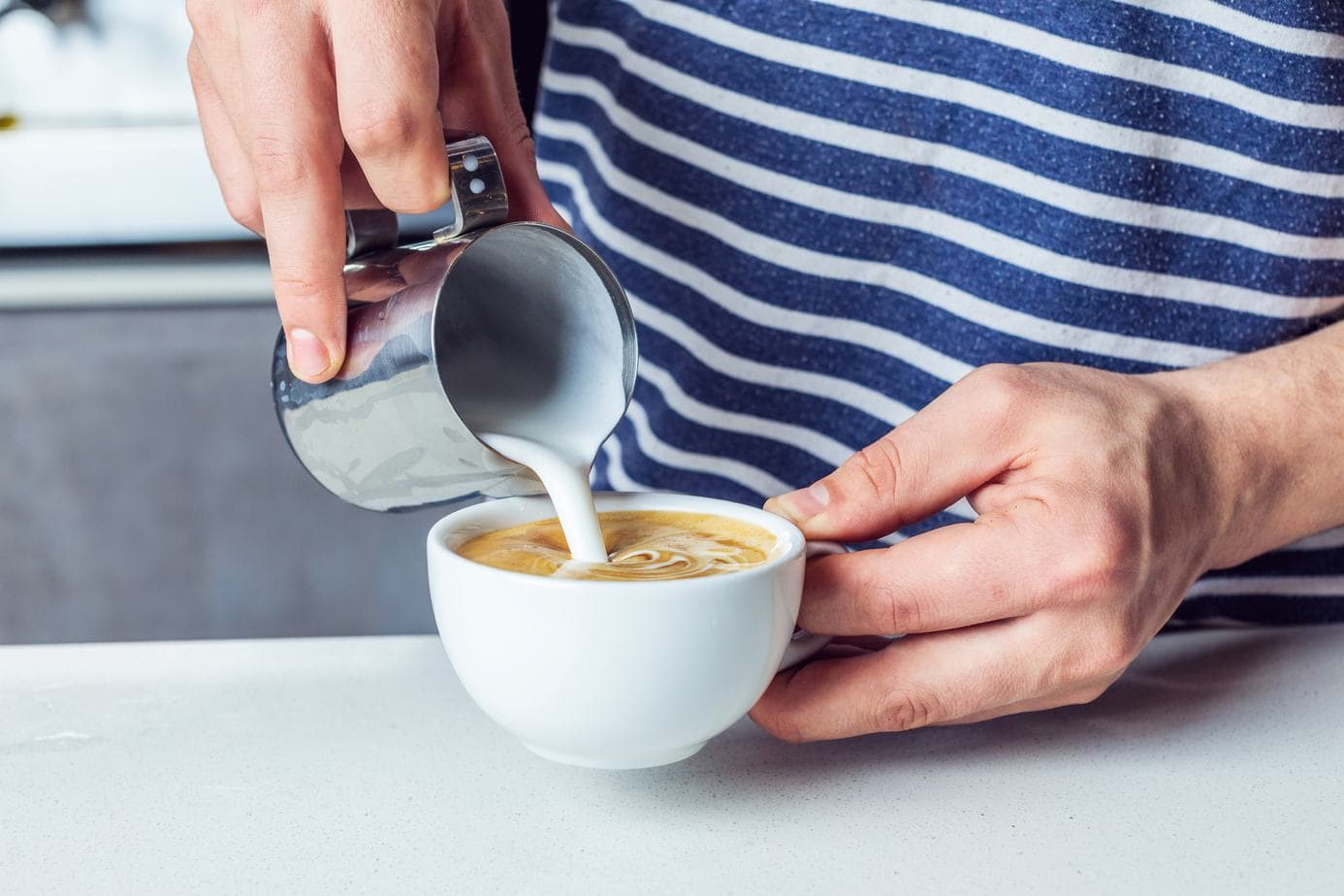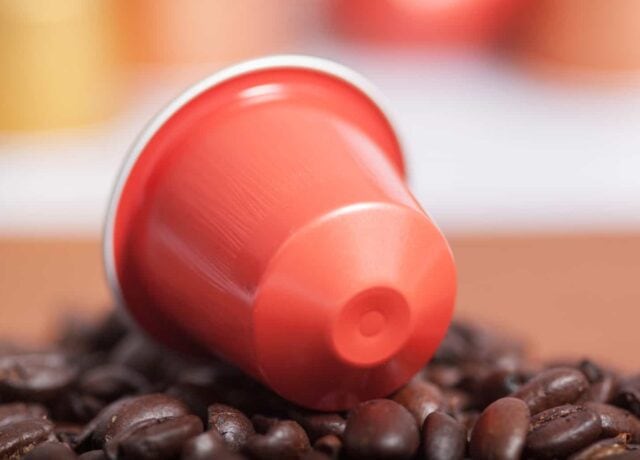Here’s a nightmare scenario for most coffee lovers: you take that first sip of your freshly brewed java and well…it just tastes off. You take another sip to be sure. Yup, no good. Is the coffee stale? Did you use too much water?
But then, it hits you. Maybe the coffee creamer you used has gone bad. You pull the container out of the fridge and give it a sniff. You notice the sour smell and immediately, your suspicions are confirmed.
A splash of spoiled coffee creamer is all it takes to ruin a perfectly good cup of coffee — and potentially your entire morning.
Is your coffee creamer bad? 4 Ways to Tell!
Does coffee creamer go bad? Yes, coffee creamer can go bad, just like plain milk or cream can spoil.
At worst, bad creamer can lead to sickness and horrible-tasting coffee at best. To avoid either unfortunate outcome, however, you’ll need to know for sure if your creamer’s bad before pouring it into your java.
Here’s how to tell if your coffee creamer is bad before using it:
Check the expiration date.
The expiration date on coffee creamer is your first clue in determining the freshness of the product. If the calendar says it’s past or even close to the expiration date, then it’s probably time to head to the store and pick up a new bottle.
Keep in mind, though, that you may not need to throw it away as soon as the calendar reaches the expiration date. Trying a few of our tips listed below is worth the effort if it means you get more use out of your creamer.

Give it the sniff test.
Let’s say you’re well within the expiration date, but you still aren’t sure if you’ve got quality creamer. That’s when you give it the sniff test.
You know what fresh creamer should smell like. Does a single whiff of what you have make you feel woozy or a little funky? If you even thought about saying yes to either of those questions or there’s even a hint of a bad smell, throw the creamer away.
Look at it.

Can you tell if coffee creamer is bad just by looking at it? Turns out, you can! Just look for certain spoilage signs.
Pour some creamer into a clear container or glass. It should come out with a smooth, almost silky consistency, much like plain milk or cream would. That’s what you want in your coffee. If it’s lumpy or separated, looking a bit like milk curdling, that’s an obvious sign you’re dealing with crummy creamer; toss it in the trash and get a new product.
If you’ve had the creamer for a rather long period of time, it may even have mold growing in it (…gross). Dark or grey spots on the liquid’s surface are sure signs of mold.
Taste it.

You’ll know if you’ve got rotten coffee creamer on your hands just by tasting it. Pour a bit onto the spoon or dip your finger into it, and give it a try.
You’ll know if the creamer is ready for consumption or not the moment it hits your tongue. If it tastes fresh, then it is. If it’s got a sour taste that makes you want to gag, it’s ready for the garbage.
How Long Do Coffee Creamers Last?
Your coffee creamer’s shelf-life will vary depending on a few factors. Use this helpful guide to determine how long each of the types of coffee creamer should last.
Dairy-Based Creamers
These creamers will usually spoil faster than other types of creamers because they’re made with milk, and nothing quite ruins a morning cup like bad milk does. Once opened, you have about 14 days to use your dairy-based creamer, but know this timeframe may vary by brand.
Non-Dairy Creamers
Non-dairy creamers typically last longer than their dairy counterparts. They can be stored at room temperature for at least a month, then up to 10 after they’ve been opened.
Powdered Creamers
Powdered creamers can last up to two years at room temperature.
What About Plant-Based Creamers?
Nowadays, dairy-free, plant-based coffee creamers are seemingly everywhere. People who want to remove dairy products from their diets but still enhance the flavor of their coffee will often seek out these plant-based milk alternatives:
- Oat milk creamer: This option has exploded in popularity over the past 2 years, and for good reason. Oat milk creamer is gluten-free and adds a subtle sweetness to any type of coffee beverage.
- Coconut milk creamer: If you enjoy using a milk frother, then coconut milk-based creamers might be for you. Coconut cream has naturally occurring healthy fats that will give you the same decadent frothy texture that you get with regular milk or cream.
- Soy milk creamer: Remember when soy was the only dairy-free alternative out there? It seems hard to believe but it’s still a popular option among millions of people. It provides a texture similar to dairy milk and comes in a wide variety of flavors. Just watch for some varieties that might have high sugar content.
- Almond milk creamer: Almond milk may be a far-gone trend for some, but don’t dismiss it outright. If you’re looking for a big flavor and low-calorie options, then you should definitely try almond milk creamers.
The guidelines for storing these plant-based creamers are all very similar. Unopened, these can all sit on the shelf for 3 to 6 months. Once opened, however, they need to be refrigerated and will last up to 10 days.
How to Store Coffee Creamers For a Long Time
The best way to store coffee creamer depends on what type you’re using. However, both dairy and non-dairy liquid creamers can be frozen to maximum freshness.
Try this hack: pour liquid coffee creamer into ice cube trays and freeze them. Then, you can just plop a cube or two into your coffee whenever you like. Worried this will cool down your coffee too much? Then place a few cubes in a container and refrigerate overnight. The next morning you’ll have fresh, liquid creamer for your coffee.
Powdered coffee creamers are just fine sitting at room temperature in a cabinet or on a shelf. You just need to keep these types of creamers away from moisture or water. After you first open the packaging, make sure that you reseal it as tightly as possible.
Or, transfer the creamer to an airtight container or plastic freezer bag to keep it fresh. Some people even store their powdered creamer in the freezer, which also helps keep it fresh but isn’t absolutely necessary.
What about single-use cups, you ask? Those little individual coffee creamers contain real milk or cream, but they do have a pretty long shelf life. Store them at room temperature and they’ll keep for about 6 months. They can also be frozen and pulled out as needed.
What If You Drink Bad Coffee Creamer?
Sometimes you may forget to test the freshness of your creamer and you wind up drinking some expired creamer. Is there any need to panic? If you’ve ingested a small or even moderate amount of bad coffee creamer, then there’s no reason to visit the emergency room.
You may experience some stomach upset, nausea, gas, bloating, or diarrhea. These symptoms are usually mild and will pass with time. If you are feeling concerned about any of your symptoms or they don’t resolve themselves within 24 hours, seek medical attention.
Coffee Creamers Are Best When Consumed Fresh
Coffee creamers can add some exciting flavor and variety to your everyday coffee. There’s no reason you shouldn’t indulge in all of the delicious varieties of coffee creamer available to you.
Just be sure to follow the tips above you when it’s time to toss your creamer containers and when it’s safe to enjoy!
Happy caffeinating!







